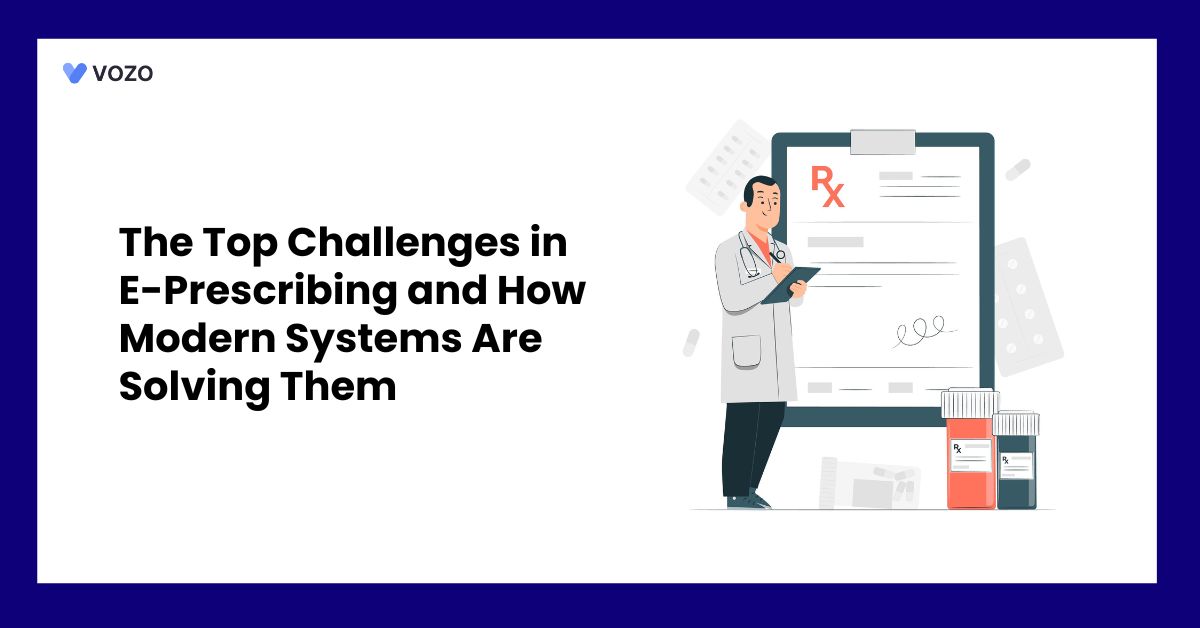The Top Challenges in E-Prescribing and How Modern Systems Are Solving Them
E-prescribing has transformed medication management by replacing handwritten scripts with digital orders. In the past decade, adoption has skyrocketed; today, over 90% of U.S. prescribers routinely send e-prescriptions. This surge reflects clear benefits: studies show e-prescribing can reduce prescription errors and healthcare costs while improving patient safety.
For example, instant access to a patient’s drug history and real-time alerts for drug interactions help avoid adverse events. Yet even as e-prescribing becomes standard, new challenges have emerged. Below, we highlight the biggest pain points and explain how modern cloud-based EHR platforms address them.
Challenges Associated with E-Prescribing and Solutions Offered by Modern Systems
1. Interoperability and Connectivity
One major challenge is system interoperability. E-prescribing only works when the clinic’s system, the pharmacy software, and other health IT components “speak the same language.” In practice, legacy systems or disparate vendors can create gaps.
Research notes that without robust data and system integration, many e-prescribing gains can’t be realized. If a physician’s EHR can’t communicate with a pharmacy’s database, an electronic prescription might fail to transmit.
Solution: Modern cloud-based e-prescribing tools adopt national standards to ensure consistent data formats.
They come pre-connected to the major pharmacy networks, meaning “virtually all pharmacies can accept e-prescriptions”. In other words, a doctor’s e-prescription will reliably reach the patient’s chosen pharmacy.
- Built-in real-time messaging and confirmation features help, too.
- For example, a cloud EHR may notify the prescriber immediately if a pharmacy rejects an order.
- These platforms often include interfaces to state prescription databases and insurance payers as well, so prescriptions and benefits data flow seamlessly.
- In short, by using cloud infrastructure and open standards, modern systems break down the silo between providers, payers, and pharmacies.
2. Data Accuracy and Medication Safety
Switching from paper to pixels solves some errors but introduces others. Studies have found that drop-down menus and structured fields in e-prescribing systems can lead to selection errors. For example, a prescriber might pick “50 mg tablet” from a menu but then type a different dose in a free-text notes field. These mismatches have been documented as unintended errors of e-prescribing.
At the pharmacy end, staff sometimes have to edit or complete missing fields, which can also introduce mistakes. In one review, researchers found that errors like wrong drug, dose, or form still occurred in up to 12% of computer-generated prescriptions.
Solution: Modern e-prescribing systems are built with multiple safeguards.
They use “forcing functions” so that no prescription can be sent with critical information missing. When a physician selects a drug, the software may auto-populate associated fields based on the medication database. If something looks inconsistent, an alert prompts the user to correct it.
Furthermore, advanced decision-support algorithms automatically check each e-prescription against formularies and patient data.
- For example, a system will flag if the entered dosage exceeds recommended limits or if the prescribed drug interacts with a medication in the patient’s record.
- Many systems also force reconciliation of medication lists, preventing duplication.
- In practice, these features mean the system can catch the vast majority of obvious entry errors before a pharmacy sees the prescription.
3. Security and Compliance
Protecting patient data and meeting regulatory rules is always a concern. E-prescribing involves transmitting personal health information and prescription orders across networks. Historically, questions arose about encrypting data and verifying user identity. Today’s solutions address this head-on.
E-prescribing platforms encrypt data in transit and at rest, and they enforce strict user authentication. Access is typically controlled by role-based permissions and audit logs, so every sent prescription is tracked. Many e-prescribing tools are housed on cloud platforms certified for HIPAA compliance, giving practices confidence that sensitive data is locked down.
Solution: All transmissions use HIPAA-compliant, encrypted channels, and systems routinely update to the latest security standards.
Modern cloud EHRs offer multi-factor authentication and digital signatures on prescriptions. This meets requirements for electronic prescribing of controlled substances and ensures only authorized clinicians can prescribe. Importantly, built-in audit trails record who signed and sent each prescription, meeting federal and state record-keeping rules.
While older systems may have struggled with secure VPN setups, cloud e-prescribing handles this behind the scenes – end users simply enjoy a secure interface without manual configuration. In this way, compliance issues become a solved problem, not a stumbling block.
4. Controlled Substances and Prescription Monitoring
E-prescribing of controlled substances adds another layer of challenge. DEA regulations require identity proofing and two-factor logins for Schedule II-V drugs.
This used to slow adoption, but recent data show rapid progress. 82% of U.S. prescribers are now EPCS-enabled, and nearly all pharmacies can process such prescriptions. In parallel, integration with Prescription Drug Monitoring Programs has become more common. These databases track controlled substance scripts to prevent “doctor shopping.”
Solution: Modern e-prescribing systems incorporate EPCS out of the box.
When a doctor prescribes a controlled medication, the software automatically enforces the DEA’s two-factor requirements.
These platforms also connect to state PDMPs through the EHR, so prescribers can view a patient’s recent controlled-substance history before sending a new script.
- In many cases, the system can auto-populate the prescription report that is submitted to the PDMP.
- Together, these features make controlled-drug prescribing both secure and convenient: physicians meet all legal requirements without a clunky separate process, and pharmacies receive verified, DEA-compliant electronic orders.
- The high EPCS adoption rate today shows that cloud e-prescribing tools have largely solved what was once a major barrier.
5. Workflow Integration and User Adoption
Even with the best technology, changes in workflow can be tough. Many clinicians were comfortable with paper or faxed prescriptions, and learning a new system takes time.
Research in early e-prescribing rollout found that providers often lacked basic computer skills and resisted change. For instance, some doctors didn’t have computers in exam rooms, and typing up orders added seconds to each patient encounter. This slowed adoption and caused frustration.
Solution: Today’s e-prescribing interfaces are much more user-friendly and integrated into daily workflow.
For example, most modern EHRs allow a prescription to be generated with just a few clicks or even by voice dictation. Common medications and dosages can be saved as favorites, letting clinicians compose routine orders in seconds.
- Training is also built in: many cloud EHRs include tooltips, guided tutorials, or even chat support to help new users.
- The goal is to make prescribing intuitive so that physicians and nurses want to use it.
- In addition, cloud systems allow mobile and tablet apps, so providers can send prescriptions on the go.
- These advances mean that today’s clinicians see e-prescribing as a time-saver, not a hassle.
- Ongoing technical support and regular system updates also ensure any user issues are quickly addressed.
- In short, the modern e-prescribing user experience has evolved to minimize the learning curve and integrate seamlessly into practice routines.
6. Network and Infrastructure Reliability
A practical hurdle is simply having a reliable connection. E-prescribing needs solid internet and server capacity. Early studies noted “insufficient bandwidth” and outdated hardware as common obstacles. In some clinics, slow networks made e-prescribing lag or even stall, creating long patient queues.
Solution: Cloud-based e-prescribing platforms eliminate most of these problems.
By hosting the application on scalable, high-availability servers, the system dynamically allocates computing and network resources. Clinicians see instant response times even if the local office has only modest bandwidth.
- Many systems also use intelligent sync so that prescriptions are queued and sent once connectivity is restored, allowing offline data entry if needed.
- Moreover, cloud platforms offer built-in redundancy: if one data center has an outage, another can take over with no noticeable downtime.
- For clinics, this means they rarely have to worry about the technology; the e-prescribing tool just runs smoothly.
7. Cost and Efficiency Gains
Finally, there is the cost factor. Implementing e-prescribing requires investment. However, studies have shown these costs are quickly offset by savings. For example, integrating prescribing into an EHR reduces manual billing and pharmacy callbacks, saving staff time.
More importantly, preventing just a few serious medication errors can save thousands in liability and health costs. A review notes that e-prescribing’s benefits include lower healthcare costs and improved medication outcomes.
Solution: Modern solutions often use subscription pricing, so there’s no large upfront outlay
Cloud EHRs with built-in e-prescribing mean practices don’t have to pay separately for an e-prescribing module or hardware. The systems are maintained and updated by the vendor, lowering IT overhead.
Overall, many organizations find that the ROI on e-prescribing is positive: faster refills and fewer errors translate into concrete savings. And because cloud tools are continuously enhanced, buyers benefit from the latest features without extra cost. In effect, cutting-edge e-prescribing becomes an investment that pays for itself over time.
Vozo EHR with Built-In E-Prescription for Medication Management
Simplify your prescribing workflow and deliver safer care with Vozo’s integrated e-prescription solution, built directly into our robust EHR platform.
Vozo empowers providers with:
- Seamless e-prescription creation right from the patient’s chart
- Real-time pharmacy connectivity for faster, error-free transmission
- Automated refill requests and approval workflows
- Improved medication safety with allergy and interaction checks
- Easy access to prescription history for continuity of care
- Significant reduction in paper-based tasks and manual errors
- Cost-effective eRx tools suitable for practices of all sizes
By integrating prescribing into your EHR, Vozo helps you increase efficiency, eliminate medication errors, and improve patient satisfaction, without switching systems.
Start your free Vozo EHR trial and experience the benefits!
About the author

With more than 4 years of experience in the dynamic healthcare technology landscape, Sid specializes in crafting compelling content on topics including EHR/EMR, patient portals, healthcare automation, remote patient monitoring, and health information exchange. His expertise lies in translating cutting-edge innovations and intricate topics into engaging narratives that resonate with diverse audiences.













